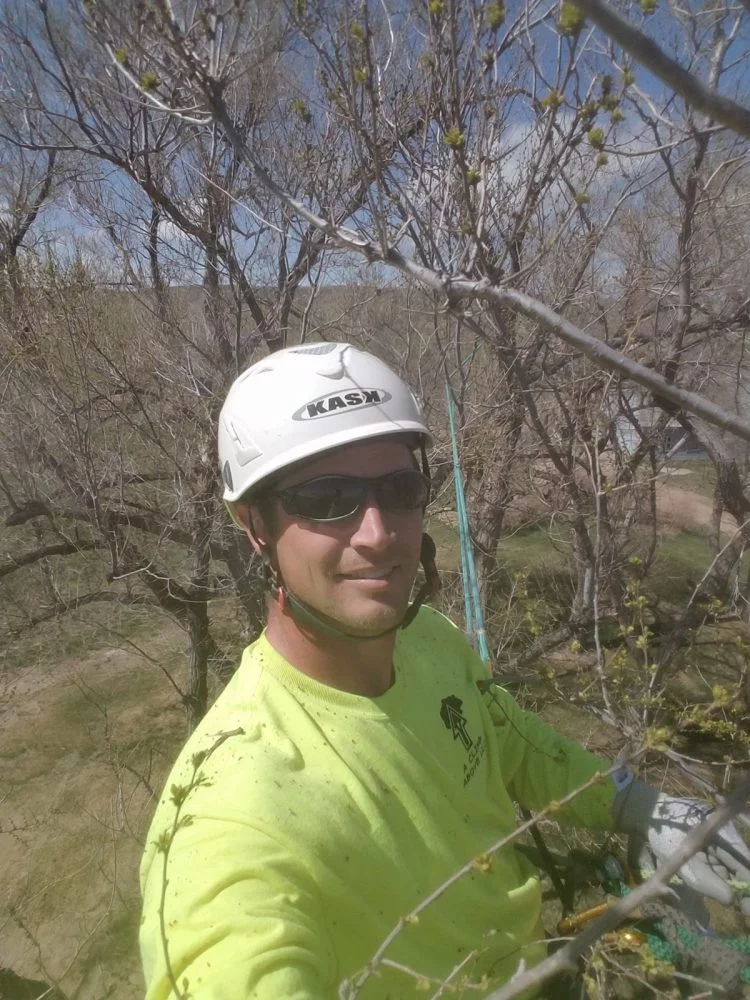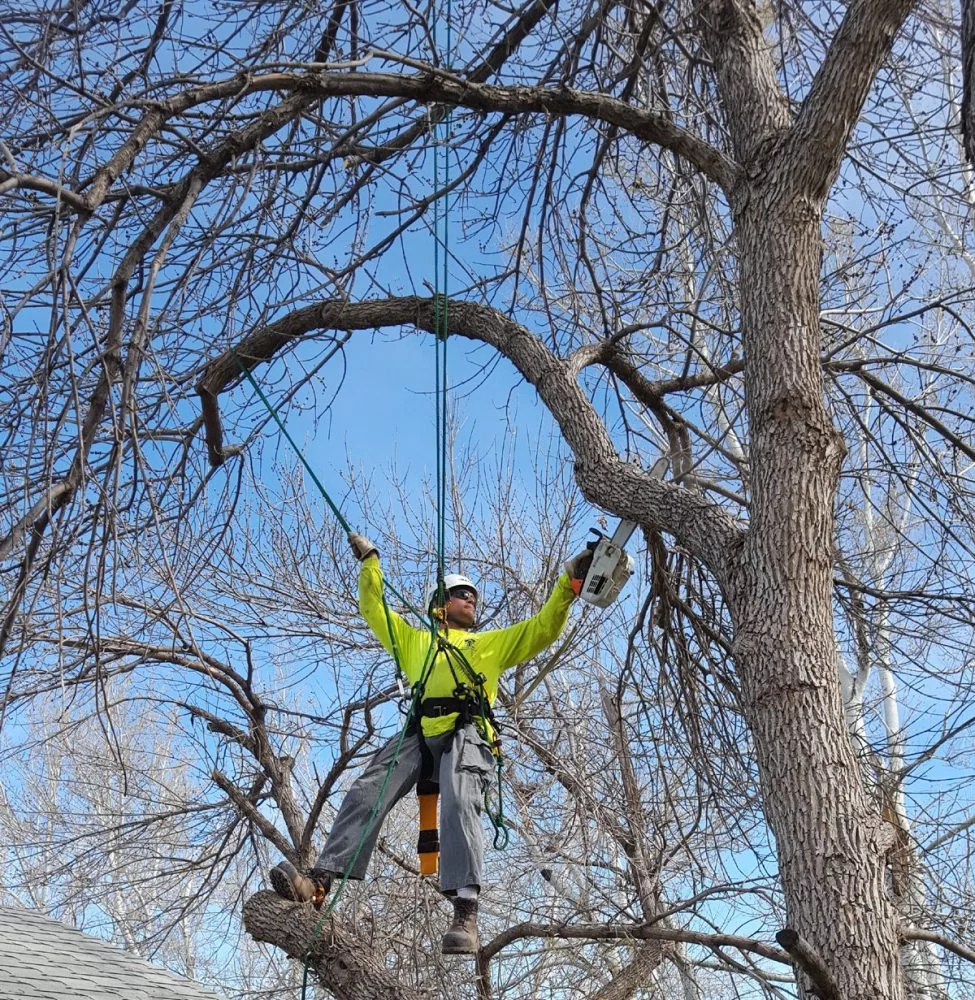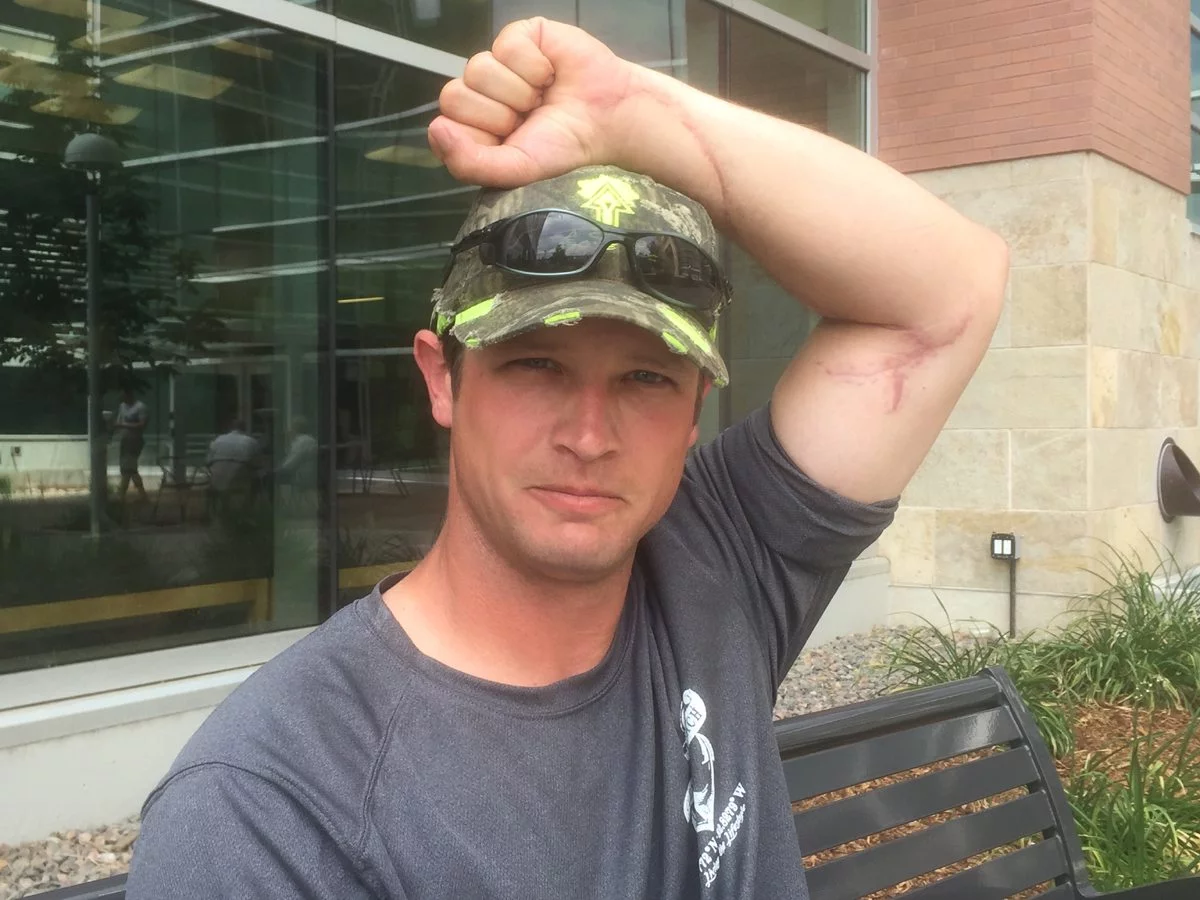Daniel Bryce is like a sculptor in the sky.
He loves nothing more than climbing dozens of feet in the air into majestic old trees. Then, anchored by safety ropes, he swings from branch to branch, shaping limbs and keeping trees healthy.

But on Easter Sunday in April, the arborist was working about 15 feet off the ground on a Chinese elm in his hometown of Gillette, Wyo. when a scary accident tested all of Bryce’s skills.
He made a cut in a branch like he has hundreds of times before. He set the break on his chainsaw and held it at rest by his right thigh. Then the limb he had cut rolled in just the wrong way and hit Bryce’s safety rope, tipping his saw up and slicing into Bryce’s left arm.
While the cut didn’t look large, Bryce knew right away that it was bad.
“It was an instant gusher, like a garden hose running out of my arm. I knew right off the bat that it was an artery,” said Bryce, 35, who also works as a coal miner and thankfully has received extensive safety and first aid training over the years.
Without thinking, Bryce sprang into action, rappelling to the ground while calling out to his assistant below.
“Call 911. You’re taking me to the hospital.”
Once on the ground, Bryce used his safety rope, called a lanyard, and wrapped it as tightly as he could high up around his armpit.
“I had to wrap it around my arm five times. I knew that was an artery in there. It was pure adrenaline,” Bryce said.
How to Stop the Bleed
- Before offering help, ensure your own safety.
- If possible, wear gloves.
- Find the source of the bleeding.
- Compress and control the wound by covering the wound or if it’s large and deep, trying to “stuff” a cloth down into the wound.
- Apply continuous pressure, pushing down as hard as you can.
- For life-threatening bleeding from an arm or leg, wrap a tourniquet about two to three inches above the injury.
- Make the tourniquet as tight as possible.
Cinching the rope so tightly that it hurt far more than the original cut, Bryce managed to create a tourniquet and stop the flow of blood.
He did this all in about 25 seconds.
“I’m glad it happened to me and not someone else. I believe everything happens for a reason and God only gives us what we can handle,” Bryce said.
Stop the Bleed – Save an arm
Doctors who cared for Bryce in Gillette and at UCHealth’s University of Colorado Hospital said he performed perfectly under pressure. His quick actions saved his life. And, as health experts work to spread the word about how everyday people can save lives during traumatic events, they are highlighting Bryce’s quick thinking as part of the Stop the Bleed campaign.
“The campaign has a goal of reaching 300 million people,” said Dr. Robert McIntyre, director of trauma and acute care surgery for University of Colorado Hospital.
“Bryce saved his own life with a tourniquet, which is exactly what we’re trying to teach immediate bystanders to do. There have been multiple high-casualty events recently and bystanders can offer immediate assistance,” McIntyre said.
Thus far, throughout the UCHealth system, trauma services experts have trained many health care workers on how to react quickly if they see someone who is losing blood due to an injury, mass shooting or attack. Those health workers, in turn, can go to schools, businesses and community groups to teach people without medical training how they can step in and save lives. The goal is to have zero preventable deaths.

Over decades, armies of everyday people have learned how to do CPR and step in if they see someone stop breathing from a drowning, heart attack or electrocution. When a person’s heart stops, people know to act fast. Blood loss is very similar in that every second counts and anyone can help. Medical experts hope bystanders can learn to have the same reflexes Bryce did. He intuitively did everything right. He stopped his bleeding, stabilized himself and then allowed medical experts to make critical decisions that saved his arm.
Bryce credits the regular first aid training he has gotten over the years at the mine and in other jobs where he’s worked with heavy equipment. He’s also a guy who gets calm when life gets crazy. During a Fourth of July celebration, a neighbor’s fireworks set off a small grass fire. While others panicked and inadvertently fanned the flames, Bryce quickly found a fire extinguisher and put out several hotspots.
“My wife calls me superman, but I don’t wear a cape. I wear a helmet,” Bryce said with a sly grin. “I don’t hesitate. I react. That’s why I saved my life.”
Once Bryce stopped the bleeding, he knew his arm was going to start swelling fast.
Drenched in his own blood, Bryce jumped in the passenger seat of his work truck while his assistant struggled to drive the stick shift. Fortunately, they only had to go a short distance before they heard sirens. An ambulance was on its way.
The EMTs included Bryce’s own sister-in-law.
“How are you?” she asked.
“I’ve lost a lot of blood,” Bryce said. “If I hadn’t gotten it to stop, I’d be dead.”
The ambulance rushed Bryce to the nearest hospital, where his arm turned blue and swelled up like a football.
Seamless medical handoff
McIntyre happened to be on call on Easter.
“I got a call from the ER in Gillette,” McIntyre recalled.

Doctors there wanted to transfer Bryce immediately to University of Colorado Hospital (UCH). But McIntyre knew that getting blood flow restored as fast as possible was critical.
“By the time the patient gets flown here and we can take care of him, he’s probably going to lose his arm,” McIntyre said.
So he urged doctors in Wyoming to create a temporary conduit called a shunt to carry blood from Bryce’s upper proximal artery to the lower distal artery.
Dr. Sara Hartsaw, a general surgeon, was enjoying Easter with her family when she got the call about Bryce’s injury. She had recently returned from serving nearly a year as a Navy surgeon in Afghanistan. Her experience there certainly helped with what she found when she arrived at the hospital.
She initially planned to do a shunt as a temporary fix and fly Bryce to UCH. She consulted with McIntyre and her partner, Dr. Jake Rinker. He was on his way to a family ranch near Montana, but detoured back to the hospital. Rinker felt he could team up with Hartsaw to do a more complex, but permanent fix called a vein graft.
The Wyoming surgeons raced against the clock. If they could complete the surgery in about 45 minutes, they felt they could restore the blood flow in time to save Bryce’s arm.
Together, they found a good vein in Bryce’s injured arm. They snipped part of that vein, reversed it and stitched it into Bryce’s damaged artery, creating a new pathway for blood. Hartsaw had done a similar procedure with surgeons in Afghanistan for a soldier who had stepped on an IED. He had had good results, so she was hopeful for Bryce.
As soon as Hartsaw and Rinker stabilized Bryce, they transferred him by helicopter to UCH.
McIntyre was there when Bryce arrived in the ICU. He found that blood was flowing well through Bryce’s arm. That’s when Dr. Ashley Ignatiuk, a plastic surgeon and hand surgery expert, took the lead and made a critical discovery. In addition to cutting through the artery, the chainsaw had sliced through about 70 percent of Bryce’s median nerve. As a result, he had lost feeling in his left thumb and fingers.
Ignatiuk said the nerves in the arm are like a bag of spaghetti. Using a microscope to see each strand, Ignatiuk carefully realigned and reconnected all the strands so they could once again send signals down Bryce’s arms to his fingers.
Little by little, the nerve pathways will regenerate and Bryce should regain full sensation in his fingers.
Bryce recently returned to Aurora for a checkup and Ignatiuk was stunned by his progress. Aside from scars, his arm looks great and the nerve regeneration is moving along faster than expected.
“This is what I call an amazing outcome,” Ignatiuk told Bryce as he tapped his forearm to detect sensation.
Bryce still has some numbness in his left thumb and forefinger, but Ignatiuk expects that to heal soon.
“Keep massaging the arm. Give it time and it will sort itself out,” Ignatiuk said. “You’re impressing the hell out of me. You’re excellent.”
Ultrasounds of Bryce vascular system also showed great results.
“The blood flow to his hand is perfect,” McIntyre said. “We want to help patients get back to doing the things they enjoy. He’s a perfect example of that.”
Bryce’s case illustrates how a smart patient and seamless medical care created a great outcome.

“The patient saved his own life. He stopped the bleed. The local doctors provided excellent care within the capacity that they could. We helped him, then sent him back. This is a partnership between the physicians and hospitals in a local community and us,” McIntyre said.
A father of four and a self-acknowledged workaholic, Bryce is feeling great and committed to regaining 100 percent of his arm and hand function.
“Use it or lose it. I’ve got kids. I’m not going to lose it,” he said.
These days, Bryce is back at work at the mine and back in the trees. Until full sensation returns to his left hand, he’s using assistants to run the chainsaw. He envisions a time soon when he’ll once again be sawing limbs.
“I’m not at all afraid of the chainsaw. I just don’t want to do large removals until I can feel it fully.”
As for the trees, he’s in heaven up in the sky.
“It’s like flying. It’s relaxing. There’s no better job out there for me. I thrive on it. I feel like a little kid.
“I will probably climb trees until I can’t anymore because I love it.”
